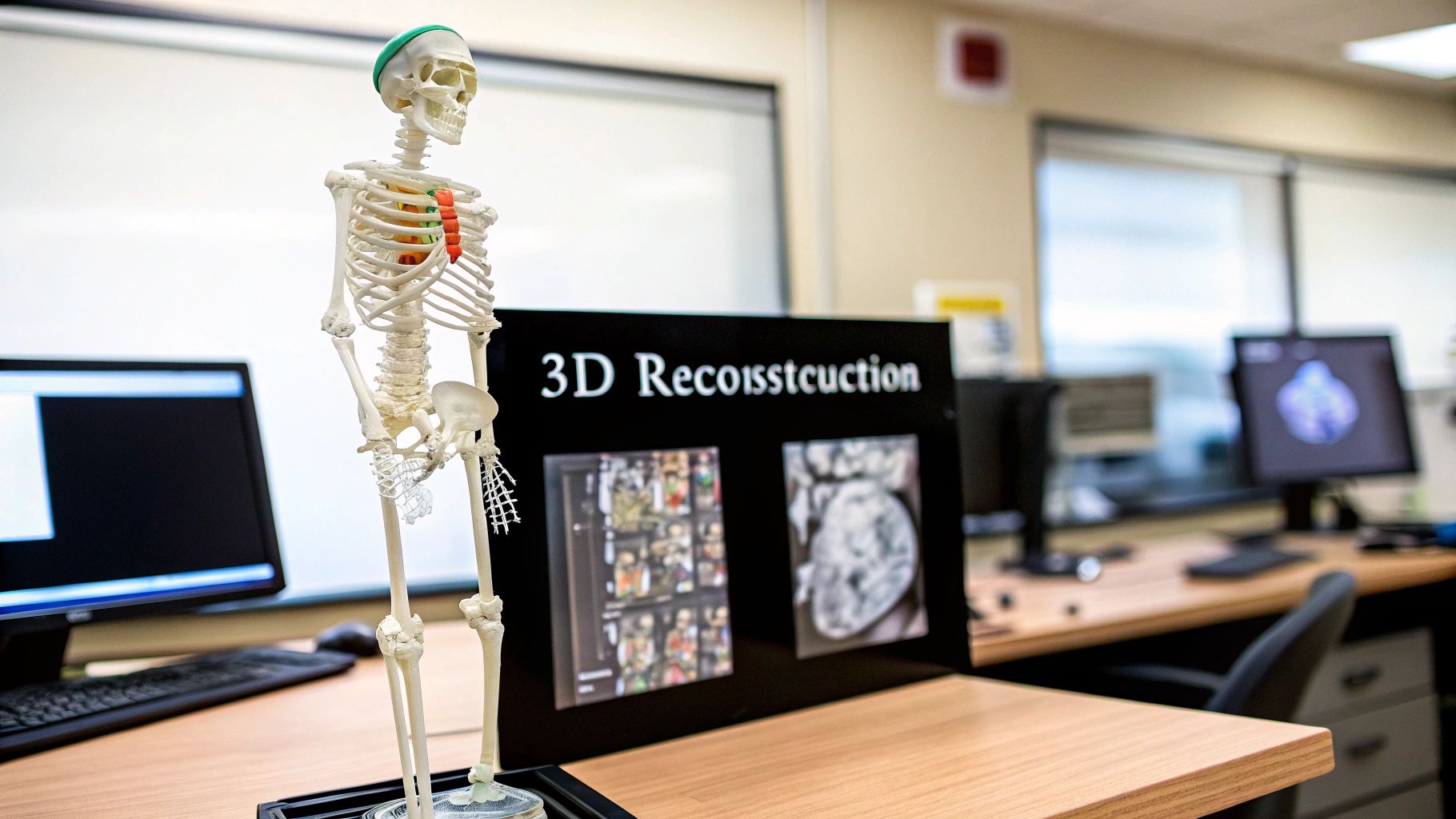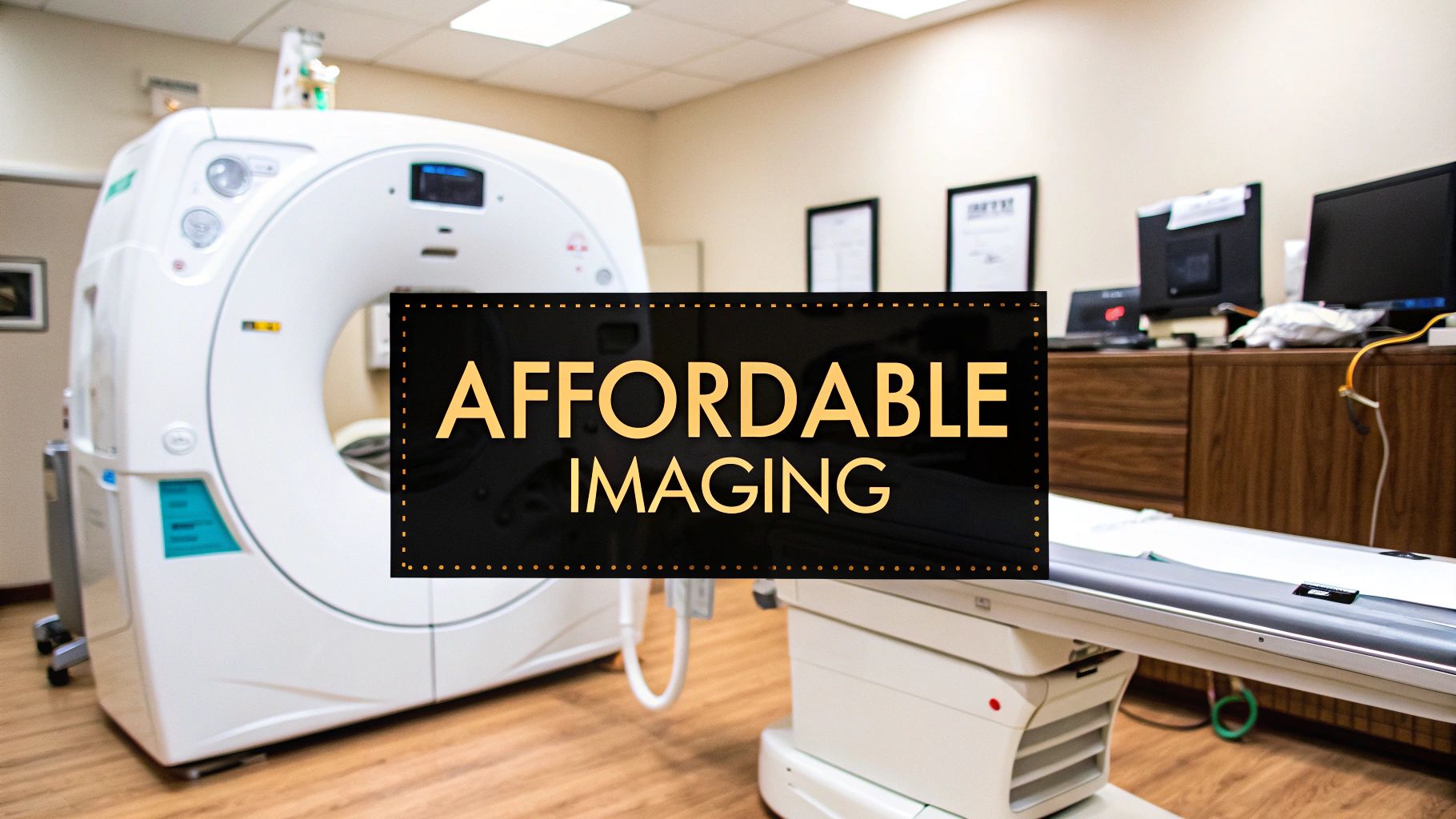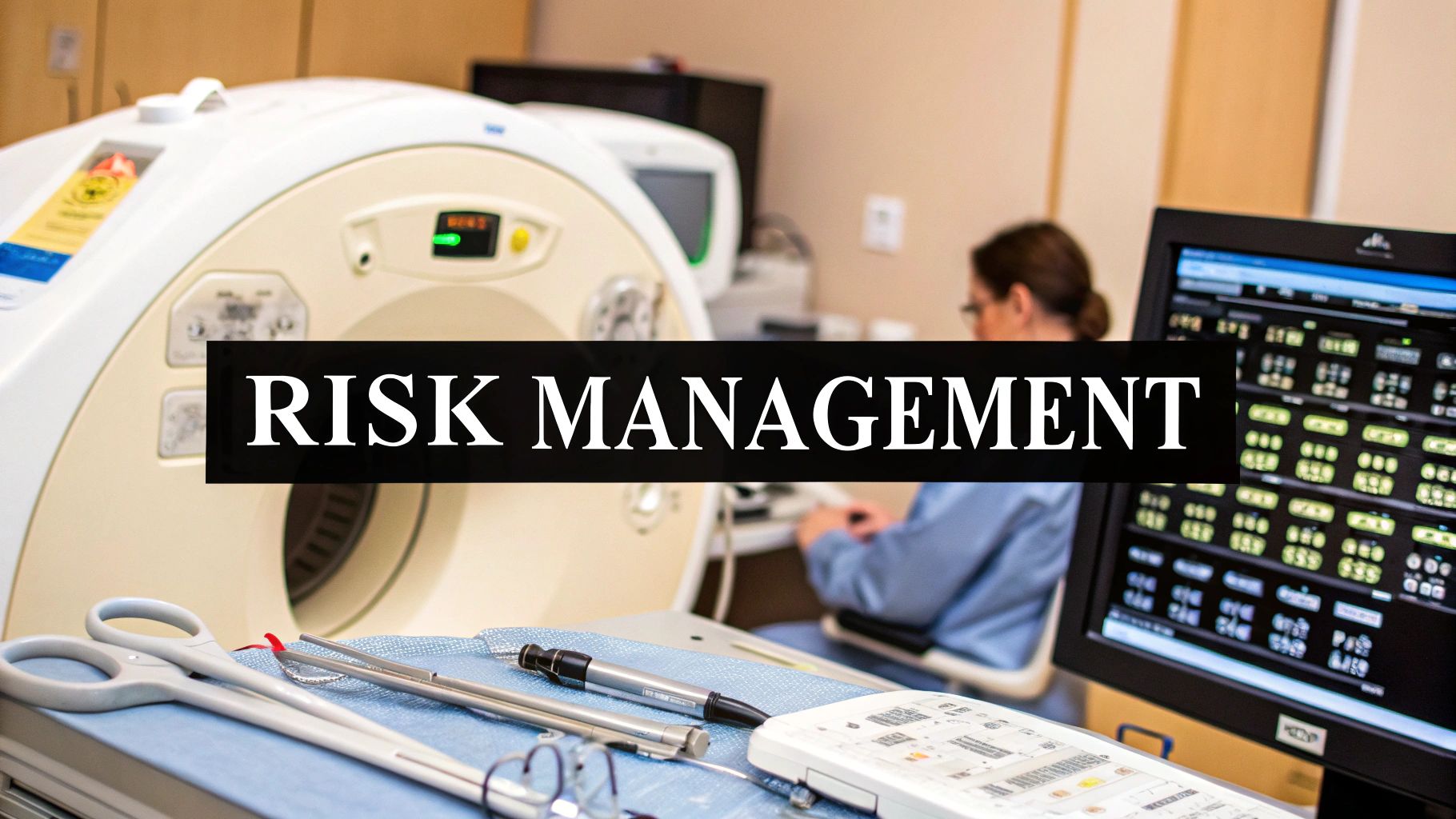Demystifying DICOM to NIfTI: Why It Matters
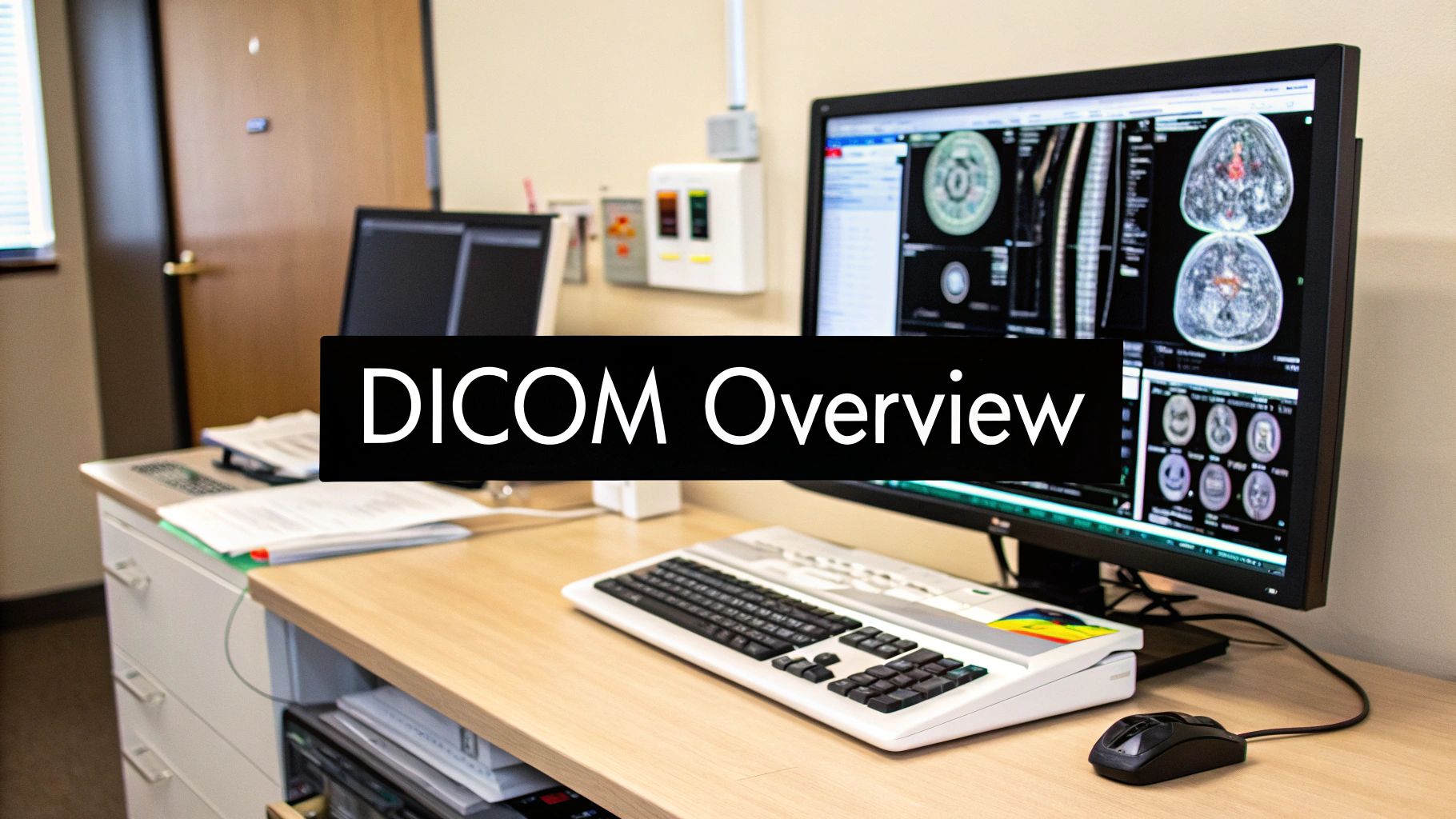
DICOM and NIfTI are two leading image formats in medical imaging. Each serves a specific purpose. DICOM (Digital Imaging and Communications in Medicine) is the established standard for clinical practice. It includes a wide range of information, from patient demographics and acquisition parameters to the image data itself. This makes it comprehensive for diagnostics and communication within healthcare.
However, this complexity can be a hurdle for research.
This is where NIfTI (Neuroimaging Informatics Technology Initiative) becomes valuable. NIfTI is a simpler format, specifically designed for neuroimaging research. It prioritizes the image data, simplifying processing and analysis with common research tools. Moving from DICOM to NIfTI opens doors for advanced analysis. It also promotes collaboration through a standardized format.
Bridging the Gap Between Clinic and Research
Converting from DICOM to NIfTI is similar to translating a detailed medical record into a focused research paper. Both hold essential information. However, they cater to different audiences and needs. DICOM might include patient history, doctor's notes, and equipment specifics. NIfTI primarily contains the 3D image data essential for research.
This conversion isn't simply changing file extensions. It's about optimizing data for its intended purpose. DICOM, with its rich header information, ensures patient privacy and data integrity within clinical environments. This richness, however, can be unwieldy when handling large datasets for research purposes.
NIfTI's streamlined structure allows for faster processing and better compatibility with specialized neuroimaging software. This lets researchers concentrate on image analysis instead of navigating complex file structures. Tools like dcm2niix are instrumental in this conversion. Dcm2niix is open-source and cross-platform compatible. It also integrates well with many neuroimaging analysis platforms.
It is known for its speed and efficiency, especially when dealing with complex DICOM images. It also has robust community support. Learn more about DICOM to NIfTI conversion tools here: Navigating the DICOM to NIfTI Conversion Landscape
Impact on Medical Advancements
The use of NIfTI has significantly advanced medical imaging research. Its simplified and standardized format enables researchers to use advanced algorithms and collaborate efficiently. This speeds up the development of new diagnostic techniques and treatments.
Moreover, NIfTI's compatibility with AI-powered tools opens up possibilities for automated analysis and new discoveries. This is driving further innovation in healthcare. By making it easier to share and analyze imaging data, DICOM to NIfTI conversion plays a vital role in shaping the future of medical research.
Essential Tools for DICOM to NIfTI Conversion Success
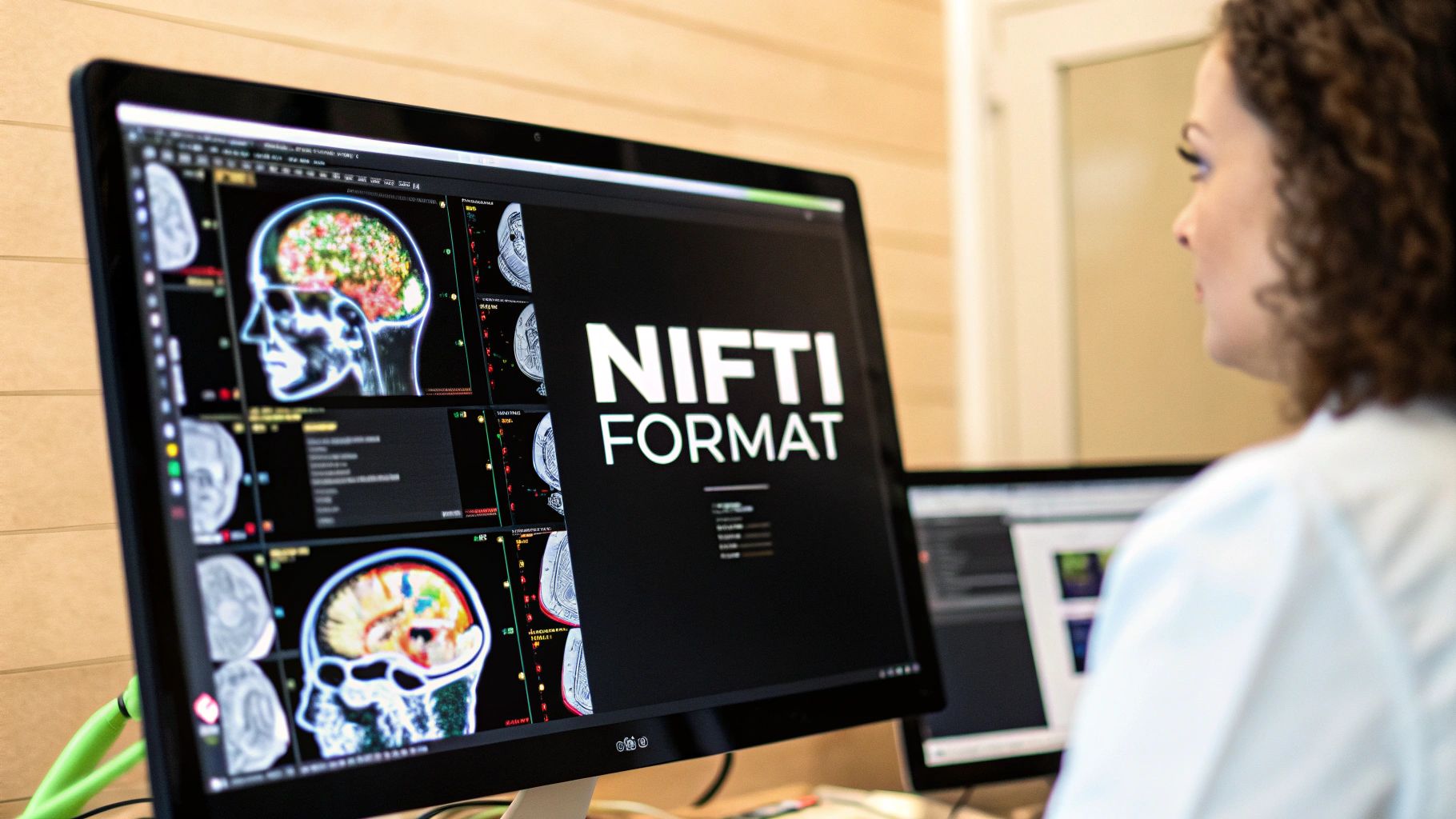
Choosing the right DICOM to NIfTI converter is crucial for efficient and accurate image processing. It's not simply a matter of changing file formats; it's about preparing your data for analysis. The tools you use significantly impact the efficiency of your workflow. This section explores several key conversion tools and offers insights into their strengths and weaknesses to empower you to make informed decisions based on your specific requirements.
Popular DICOM to NIfTI Converters
Various tools are commonly used for DICOM to NIfTI conversion. Each offers its own set of features and capabilities. Understanding these differences is essential when selecting the most appropriate tool for a given task.
-
dcm2niix: This tool is known for its speed and efficiency in handling complex DICOM data. Its active development and strong community support make it a popular choice. dcm2niix
-
dcm2nii: While an older tool, dcm2nii remains relevant, especially for handling legacy DICOM data. However, dcm2niix is often preferred for processing modern image formats.
-
3D Slicer: The 3D Slicer platform provides a wider range of medical image processing functionalities, including DICOM to NIfTI conversion. It's particularly useful when additional image manipulation or visualization is required.
-
MRIcroGL: MRIcroGL combines visualization and conversion tools. It's a convenient choice for quickly visualizing and converting data in a single environment.
Historically, the field has witnessed a shift from tools like dcm2nii to dcm2niix. This transition reflects the constantly evolving nature of medical imaging technology. Dcm2nii was initially designed for converting DICOM and other formats to NIfTI for compatibility with software like SPM and FSL. Dcm2niix, its successor, delivers better performance, especially with modern DICOM images. This evolution underscores the need for adaptable and up-to-date conversion tools. Learn more about the history of these tools here.
Choosing the Right Tool
Selecting the right tool depends on various factors, including the complexity of your data, the project's scale, and specific research requirements. For a single case study, a simpler tool like MRIcroGL might suffice. However, for large-scale, multi-center trials involving thousands of scans, the speed and automation capabilities of dcm2niix become essential.
To help you choose the best fit for your needs, let's compare these tools side-by-side.
The following table provides a comparison of the discussed DICOM to NIfTI conversion tools.
Comparison of DICOM to NIfTI Conversion Tools
| Tool Name | Platforms | Speed | Metadata Preservation | Ease of Use | Active Development |
|---|---|---|---|---|---|
| dcm2niix | Cross-Platform | Very Fast | Excellent | Command-line; can be challenging for beginners | Yes |
| dcm2nii | Cross-Platform | Slower than dcm2niix | Good | Command-line; can be challenging for beginners | Limited |
| 3D Slicer | Cross-Platform | Moderate | Excellent | GUI; Relatively easy to use | Yes |
| MRIcroGL | Cross-Platform | Fast | Good | GUI; Easy to use | Yes |
As the table highlights, each tool presents a trade-off between speed, ease of use, and features. While dcm2niix excels in speed and metadata preservation, its command-line interface may present a learning curve for new users. 3D Slicer offers a more user-friendly experience but may not be as fast as dcm2niix. Choosing the right tool involves balancing these considerations based on your specific needs.
Key Features to Consider
Several key features are essential for successful DICOM to NIfTI conversion, regardless of the specific tool used:
-
Metadata Preservation: Maintaining data integrity requires that crucial metadata is carried over during the conversion process.
-
Handling Complex Image Series: The tool should be able to reliably handle various image acquisition protocols and diverse data structures.
-
Integration with Analysis Pipelines: Seamless integration with downstream analysis tools simplifies workflows.
-
Platform Compatibility: Select a tool that's compatible with your operating system.
-
User Interface and Support: A user-friendly interface and comprehensive documentation are vital, particularly for those new to the tools.
By carefully considering these features, you can select a DICOM to NIfTI converter that effectively meets your needs, ensuring the accurate and efficient processing of your imaging data. This, in turn, provides a solid foundation for robust research and improved patient care.
Converting DICOM to NIfTI: Your Step-by-Step Blueprint
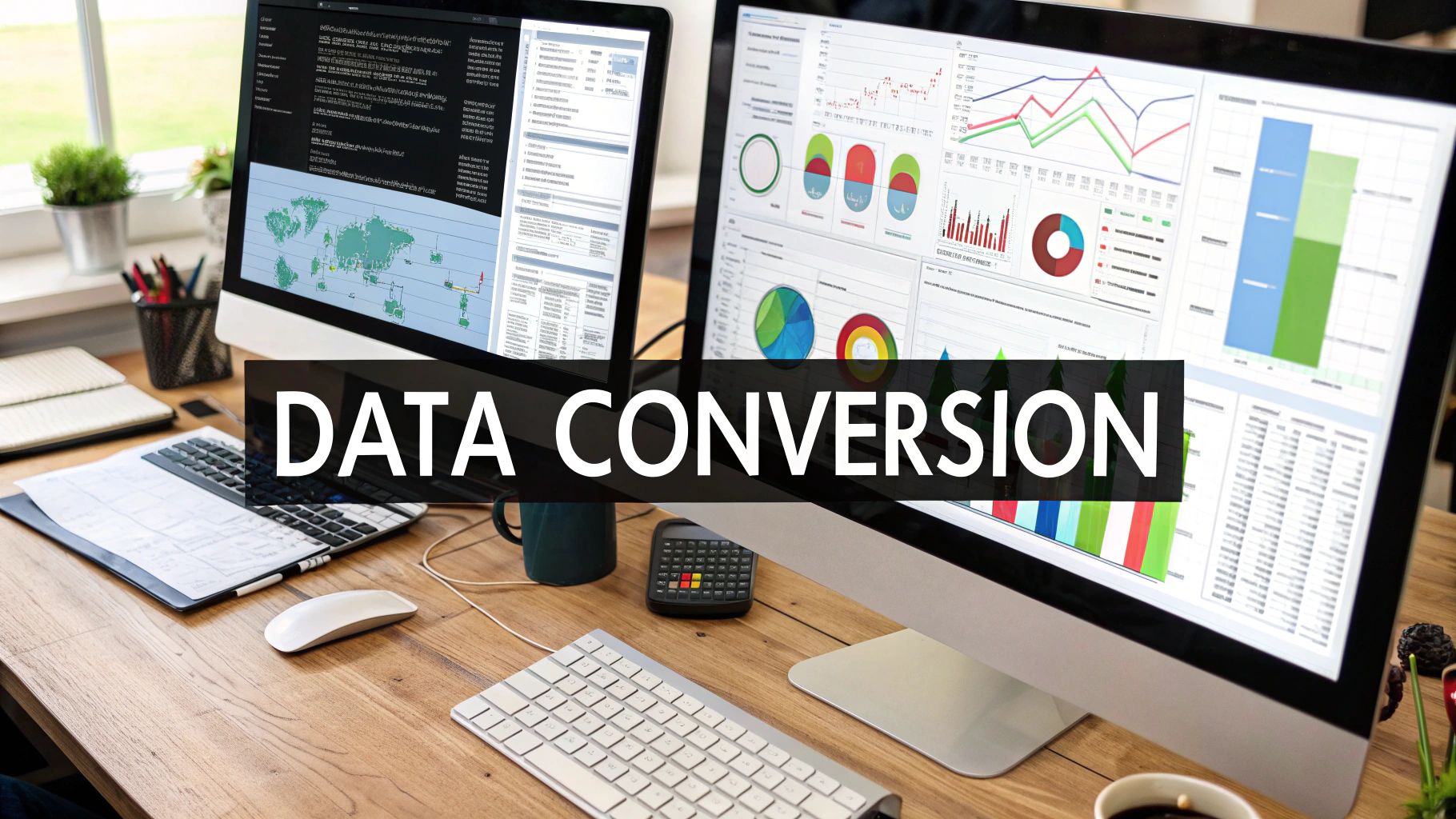
Having explored the various tools available for DICOM to NIfTI conversion, let's delve into a practical, step-by-step guide. This blueprint will take you through each stage of the process, from organizing your files to validating the final output.
Organizing Your DICOM Files
The initial step is organizing your DICOM files. A well-structured system is essential for efficient batch processing and minimizing potential errors. Think of it as prepping ingredients before cooking—everything in its designated spot makes the process run smoother. Create a dedicated folder for your source DICOM files. Within this folder, organize them by patient or study. This initial organization will be invaluable later.
Choosing the Right Conversion Tool
Next, select the right tool based on your specific needs. Recall our earlier discussion of dcm2niix, dcm2nii, 3D Slicer, and MRIcroGL? Each tool has its strengths. If speed and metadata preservation are paramount, dcm2niix is a good choice. If a user-friendly interface is more important, MRIcroGL may be a better fit. Selecting the right tool is foundational for a smooth conversion. Thorough code documentation is also important for maintainability and collaboration.
Initiating the Conversion Process
With your files organized and your tool selected, you're ready to begin. Most tools offer both command-line and GUI options. The command-line offers greater flexibility for batch processing, while the GUI is generally more intuitive for individual conversions. For example, using dcm2niix via the command line allows you to process an entire directory with a single command. This is particularly useful for large datasets.
Batch Processing for Efficiency
Batch processing is essential for large datasets. This automates the conversion of multiple files, saving significant time and effort. Tools like dcm2niix offer powerful batch processing capabilities. Converting thousands of DICOM files manually would be a daunting task. Batch processing streamlines this, allowing you to focus on analysis instead.
Preserving Crucial Metadata
During conversion, make sure crucial metadata is preserved. This information, such as acquisition parameters and patient details, is often essential for research. Many tools allow you to configure the level of metadata retention. Think of this as retaining crucial notes from medical records when transferring information.
Validation and Quality Assurance
After conversion, validating your NIfTI files is critical. This confirms data integrity and ensures a successful conversion process. Tools like MRIcroGL allow you to visually inspect the converted images. Compare them with the original DICOM data to ensure structural integrity. This step guarantees you are working with accurate data.
Automation for Streamlined Workflows
Once you’ve established a reliable conversion process, consider automating it. This saves time and reduces the risk of human error. Scripting can automate the entire workflow, from file organization to validation. This creates a more efficient and consistent process for future conversions, similar to setting up a recurring task.
Troubleshooting Common Issues
Even with careful planning, issues can arise. Orientation problems, slice misalignments, and metadata corruption are common challenges. Understanding these potential problems and their solutions is key for efficient troubleshooting. For instance, if the orientation of your NIfTI image is incorrect, check the orientation parameters in your chosen conversion tool. A structured troubleshooting approach makes challenges manageable.
By following this blueprint, you can confidently convert DICOM to NIfTI, ensuring data integrity and optimizing your research workflow. This structured approach, combined with the right tool selection, sets a strong foundation for insightful analysis and ultimately contributes to more reliable research outcomes.
Preserving Critical Metadata in Your DICOM to NIfTI Workflow

Successfully converting data from the DICOM format to the NIfTI format involves more than just transferring image pixels. It requires careful attention to preserving vital metadata, which is essentially information about the image and the patient. This descriptive data is crucial for conducting meaningful medical research. This section explores the importance of metadata retention and provides practical guidance on ensuring its integrity during the conversion process.
Why Metadata Matters in Research
Metadata provides essential context for medical images. Imagine a photograph without knowing when, where, or how it was taken. The image loses much of its meaning. Medical imaging data without metadata suffers a similar fate. Key acquisition parameters, such as magnetic field strength and echo time, are essential for interpreting results and ensuring the reproducibility of research experiments. Without this context, research findings can become unreliable and difficult to validate.
Metadata Preservation Techniques
Several effective strategies can be implemented to preserve metadata during DICOM to NIfTI conversion. A common and highly recommended approach utilizes JSON sidecar files. These files, directly linked to the NIfTI image file, store the rich metadata extracted from the original DICOM file. This approach leverages a structured and readily accessible format. The JSON sidecar method allows the NIfTI image file to remain compact while providing comprehensive access to all necessary contextual information.
Which Metadata to Preserve
While specific metadata needs vary depending on the research question, certain elements are universally important.
- Acquisition Parameters: These parameters describe the image acquisition process, including vital information such as scanner type, sequence details, and precise timing information.
- Patient Information: De-identified patient information, including demographics like age and sex, is often crucial for effective data analysis, especially in studies investigating population-based patterns.
- Study Information: Essential study details like the study date and the institution where the data was acquired allow for better data provenance tracking, and even potential linkage to other relevant data sources.
Practical Workflows for Metadata Validation
Post-conversion, validating the transferred metadata is paramount. This crucial step helps ensure that no data loss occurred during the conversion process. Tools such as dcm2niix generate detailed reports about the preserved metadata, facilitating efficient validation. Furthermore, a manual comparison between the original DICOM metadata and the accompanying JSON sidecar file can confirm the integrity and completeness of the transferred information.
Implementing Metadata Quality Assurance
Integrating metadata quality assurance into your image processing workflow significantly enhances both reproducibility and overall data integrity. Tools like PYCAD offer advanced features for comprehensive metadata verification and validation. This proactive approach strengthens the reliability of your research by ensuring the completeness of metadata throughout the entire DICOM to NIfTI workflow.
Real-World Impacts of Metadata Loss
Consider a study analyzing changes in brain volume over time. If crucial information like the scanner model or field strength is lost during conversion, observed differences could be erroneously attributed to biological changes when, in reality, they might stem from equipment variations. Metadata preservation safeguards against these types of misinterpretations, ensuring the accuracy and reliability of research outcomes.
Beyond Conversion: Metadata in Research Pipelines
Metadata plays a critical role extending beyond format conversion and into downstream analysis. Its presence enables efficient data filtering and querying, optimizing the research process. For example, researchers can easily select images acquired with a specific pulse sequence or focus their analysis on patients within a particular age range. This efficient access to relevant data streamlines research efforts and empowers researchers to conduct more targeted and insightful analyses. By prioritizing metadata, your DICOM to NIfTI workflow becomes more than a simple format change – it becomes a cornerstone of scientific integrity.
DICOM to NIfTI: Transforming Medical Research Worldwide
The conversion of DICOM (Digital Imaging and Communications in Medicine) to NIfTI (Neuroimaging Informatics Technology Initiative) format has become essential for modern medical research. This seemingly simple change unlocks powerful analytical capabilities, allowing researchers to extract valuable insights from complex medical images across various disciplines. Think of it like converting raw survey data into easy-to-understand charts and graphs.
Empowering Research Through Standardization
NIfTI's standardized format simplifies analysis and promotes collaboration, especially crucial in multi-center trials. These trials often involve combining data from various institutions using different equipment. NIfTI acts as a common language for medical image data, making this complex task manageable.
For example, in brain connectivity mapping, researchers use converted NIfTI images to explore the intricate networks within the brain, advancing our understanding of neurological conditions. This standardization enables the analysis of large datasets from diverse sources, pushing the boundaries of neuroscience.
Quantitative Imaging: A New Era of Medical Insights
DICOM to NIfTI conversion has also been vital for the growth of quantitative imaging. This approach shifts the focus from qualitative, visual observations to extracting measurable data from medical images. Quantitative measurements offer objective insights, allowing researchers to track subtle changes, predict treatment outcomes, and personalize therapies.
This is similar to shifting from describing a patient's symptoms to measuring specific physiological indicators, dramatically increasing detail and accuracy. The importance of this conversion is further highlighted by its role in fields like radiation oncology. Here, techniques like radiomics extract data from medical images for advanced analysis. The conversion to NIfTI is often a prerequisite for the computational processing these techniques require. By 2021, radiomics research had achieved significant maturity, demonstrating this conversion's crucial role. Find more detailed statistics from Maastricht University Research.
AI and the Future of Medical Imaging
The trend toward quantitative imaging is amplified by the integration of artificial intelligence (AI). Researchers now combine converted NIfTI images with sophisticated AI models to uncover patterns undetectable by the human eye. These AI-powered tools can identify subtle image anomalies, predict disease progression, and even recommend optimal treatment strategies. This powerful combination is transforming various medical fields, from neurology to cardiology.
This conversion also facilitates the use of AI-driven medical image analysis tools like PYCAD. PYCAD integrates seamlessly with NIfTI data, enhancing research and clinical applications.
Collaboration and Data Sharing: A Catalyst for Discovery
The accessibility and standardization of the NIfTI format have significantly impacted data sharing initiatives. Researchers can easily share imaging data globally, fostering collaboration and accelerating discoveries. This open exchange promotes faster validation of research findings and the development of innovative solutions for complex medical problems. DICOM to NIfTI conversion is more than a technical process; it's a catalyst for progress in medical science.
To further illustrate the widespread adoption and utility of this conversion process, let's look at some specific applications across different medical specialties.
The following table provides an overview of how various medical specialties leverage converted imaging data for specific analytical applications.
Research Fields Utilizing DICOM to NIfTI Conversion
| Medical Specialty | Primary Analysis Types | Key Software Tools | Research Outcomes |
|---|---|---|---|
| Neurology | Brain connectivity mapping, lesion segmentation, volumetric analysis | FSL, SPM, AFNI | Improved understanding of neurological disorders, development of biomarkers for disease progression |
| Oncology | Tumor segmentation, radiomics feature extraction, treatment response assessment | 3D Slicer, ITK-SNAP | Personalized treatment planning, improved prediction of treatment outcomes |
| Cardiology | Cardiac image segmentation, quantification of blood flow, assessment of heart function | Segment, Osirix | Early detection of heart disease, improved monitoring of cardiac conditions |
This table highlights the diverse range of applications and the specialized software tools used in conjunction with NIfTI data across different medical fields. The conversion process plays a pivotal role in enabling these analyses and contributes significantly to advancements in medical research and patient care.
Troubleshooting DICOM to NIfTI Conversion: Expert Solutions
Converting DICOM to NIfTI, while generally straightforward, can occasionally present challenges. This section provides practical solutions to common issues encountered by imaging specialists. We'll explore diagnosing and resolving problems such as orientation discrepancies, slice misalignments, and metadata corruption. Consider this your essential toolkit for overcoming conversion obstacles.
Common Conversion Issues and Their Solutions
-
Orientation Problems: Incorrect image orientation is a frequent problem. This can appear as flipped, rotated, or misaligned images. For diagnosis, visually compare the NIfTI image to the original DICOM data using a viewer like MRIcroGL. Carefully examine the orientation matrices in the NIfTI header for any inconsistencies. Many conversion tools offer the ability to adjust orientation parameters during the process. Experimentation with these parameters often resolves the issue.
-
Slice Misalignments: Occasionally, slices within a 3D NIfTI image may not align correctly. This can result in a “stair-step” effect or other distortions, particularly noticeable in 3D visualizations. Begin by checking the slice order and spacing information contained within the NIfTI header. Verify that these values correspond to the original DICOM data. Tools like 3D Slicer provide image resampling and realignment features to correct misalignments post-conversion if needed.
-
Metadata Corruption or Loss: Metadata, crucial for image interpretation, can be corrupted or lost during conversion. This can impact analysis and reproducibility. To prevent this, prioritize tools that generate JSON sidecar files, which effectively preserve metadata. If metadata issues do occur, re-run the conversion, paying close attention to the metadata preservation settings within your chosen tool. Validate the integrity of the NIfTI metadata by comparing it to the original DICOM header information.
Quality Control Procedures for Conversions
Implementing robust quality control procedures is vital for early detection and resolution of conversion issues.
-
Visual Inspection: Visually compare the DICOM and NIfTI images side-by-side. Confirm that anatomical structures are correctly aligned. Pay close attention to image orientation, slice alignment, and overall image quality. This initial step can reveal obvious errors.
-
Header Verification: Check the header information in both the DICOM and NIfTI files. Verify that key parameters, such as image dimensions, voxel sizes, and data type are consistent. Discrepancies may indicate more subtle problems.
-
Software Validation: Test the converted NIfTI files within your intended analysis software. Confirm they load correctly and produce the expected results. This proactive step helps catch compatibility issues early.
Scanner-Specific Considerations
Variations in scanner types and acquisition protocols can introduce unique conversion challenges.
-
Parameter Adjustments: Certain conversion tools require specific parameter adjustments for different scanners. Refer to the tool’s documentation for specific guidance.
-
Testing Datasets: Before converting large datasets, create a small test dataset from your scanner. This proactive approach helps identify any scanner-specific issues early on.
Advanced Troubleshooting Resources
-
Online Forums and Communities: Neuroimaging communities and tool-specific forums offer valuable troubleshooting advice and solutions from experienced users.
-
Consulting Experts: For complex problems, consider consulting imaging specialists or bioinformaticians with expertise in DICOM to NIfTI conversion. Their guidance can save significant time and effort.
By understanding common issues and implementing these diagnostic and quality control measures, you can effectively address conversion challenges, ensuring reliable and reproducible research results. Consider this structured troubleshooting process as a roadmap for transforming complex challenges into manageable solutions.
Ready to enhance your medical image analysis workflow? Explore PYCAD's AI platform. We offer a comprehensive suite of tools, including DICOM to NIfTI conversion and automated image analysis.



